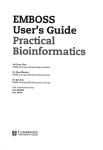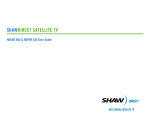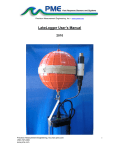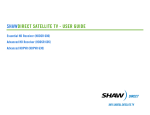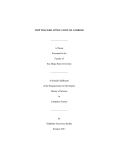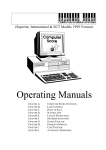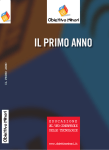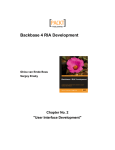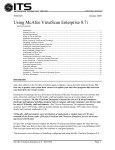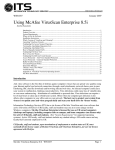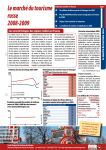Download ONLINE TV AND VIDEO 2015
Transcript
STICHTING KIJKONDERZOEK ONLINE TV AND VIDEO 2015 METHODOLOGICAL DESCR IPTION `` STICHTING KIJKONDERZOEK OTV ONLINE TV AND VIDEO 2015 METHODOLOGICAL DESCRIPTION AMSTERDAM 03-02-2015 This document is written by SKO Office in collaboration with comScore and GfK. © Author’s copyright. Any unauthorised use of the document subsequent to its publication in an electronic or other medium or distribution or publication of said document to others who obtain copies of it by any means without written authorisation by SKO, shall constitute an infringement of the Author's copyright. Table of contents INTRODUCTION ..................................................................................................................................... 1 1. CONTENT TYPES: WHICH STREAMS ARE MEASURED? ............................................................. 2 1.1. TV BROADCAST: ......................................................................................................................... 3 1.1.1. “LIVE” STREAMS / LINEAR STREAMS ................................................................................ 3 1.1.2. ON DEMAND STREAMS, EPISODES .................................................................................. 3 1.1.3. SEGMENTS ........................................................................................................................... 3 1.1.4. PREVIEWS ............................................................................................................................ 4 1.2. ONLINE ONLY CONTENT ........................................................................................................... 4 1.2.1.1. LIVE/LINEAR AND ONLINE ONLY .................................................................................... 4 1.2.1.2. BROADCAST OR PROGRAMME (FRAGMENT) ONLINE ONLY ..................................... 4 2. MEASUREMENT ................................................................................................................................ 6 CERTIFICATION OT&V MEASUREMENT SYSTEMS .............................................................. 7 METADATA ................................................................................................................................ 7 2.1. MEASUREMENT OF ONLINE VIDEO BEHAVIOUR ................................................................... 8 PIXEL METHOD ......................................................................................................................... 9 STREAM SENSETM .................................................................................................................... 9 PLAYING TIME ......................................................................................................................... 11 JAVASCRIPT ............................................................................................................................ 11 HEARTBEAT ............................................................................................................................ 12 2.2. BROADCAST DATA ................................................................................................................... 12 FRAGMENTS (.SEG) ............................................................................................................... 14 ONLINE ONLY CONTENT (TC. CAM, TC.PROG AND TC.WEB)........................................... 14 3. MATCHING STREAMS AND BROADCAST DATA ........................................................................ 17 3.1. AUTOMATIC MATCHING .......................................................................................................... 17 PROG ID ................................................................................................................................... 18 OTHER SKO LABELS .............................................................................................................. 18 3.2. MATCHING APPLICATION ........................................................................................................ 19 3.3.PRL ID: MATCHING KEYS TO DAILY PRL FILES ..................................................................... 20 3.4. LINEAR STREAMING................................................................................................................. 21 4. CONTROL PROCEDURES .............................................................................................................. 23 5. OTV REPORTING ............................................................................................................................. 27 5.1. WEBSITE REPORTING ............................................................................................................. 28 PREVIOUS REPORTING ......................................................................................................... 28 SCOPE WEBSITE EN SKO APP REPORTING 2014 ............................................................. 28 SKO RESULT TYPES ............................................................................................................. 29 5.2. ONLINE TV & VIDEO ANALYSIS TOOL .................................................................................... 30 5.3 AGREGGATED OTV DATA FILES ............................................................................................. 32 5.4 RAW OTV DATA FILES............................................................................................................... 32 5.5. AVAILABILITY OF REPORTS .................................................................................................... 33 5.6 NEXT STEPS ............................................................................................................................... 34 INTRODUCTION Stichting KijkOnderzoek (SKO) sets great store by offering an independent view on developments and relations in the streaming TV and video-content market. Since 2008, SKO has been mapping online viewing behaviour for television programmes available through the internet. The project's goal is to measure all online TV-content viewing, of both complete programmes and fragments, of all channels participating with SKO. In 2013, SKO revealed its new strategy. Since that time, the aim has been to measure not only TV-related content, but all professional online video content, including content of broadcasters and other online video parties affiliated with SKO. Previously unaired TVrelated content or online only content also lies within the project's scope. The measurements take place inside the player that plays the video. The measurements are instrumental in answering such questions as: • How many times was a given online video stream accessed? • How often was the video viewed? • For how long was the video viewed? • What was the average viewing time? • Which streams are most often viewed in their entirety? • Which type of online video content is most popular? • For videos of programme already broadcasted on TV: how do these results compare to those of TV-viewing? This document describes the methodology used in SKO Online TV & VIDEO measurement and reporting. This document will be updated as new reports are introduced and/or existing reports adapted. Page 1 of 34 CHAPTER 1 ONLINE CONTENT TYPES Page 2 of 34 1. CONTENT TYPES: WHICH STREAMS ARE MEASURED? SKO's Technical Committee has ranked the available video streams according to the following classification: TABLE 1 Linear TV broadcast Online only content Live and simultaneous to TV Live and online-only content. broadcasts Exclusive online content, i.e. content made specifically for online Time Content (broadcast or fragment of a use or content related to a specific Shifted broadcast) previously aired on TV TV broadcast (broadcast, fragment of a broadcast) or generally to a TV programme title. Preview Content (broadcast, fragment of a broadcast) aired later on TV 1.1. TV BROADCAST: This type of content contains online video streams with identical content to broadcasts previously or simultaneously aired on television. 1.1.1. “LIVE” STREAMS / LINEAR STREAMS Streams offered concurrent with the program's television broadcast. Example: the live stream of NPO Live TV (http://www.npo.nl/live). 1.1.2. ON DEMAND STREAMS, EPISODES Streams of programmes that have already been aired on TV. The content of the stream is identical to that of the complete TV broadcast. Example: a stream of an episode of the programme ‘Wie trouwt mijn zoon’, aired at an earlier date by SBS 6. 1.1.3. SEGMENTS Streams of a fragment of a broadcast already aired on TV. For example: a single performance from RTL5's broadcasted programme “So you think you can dance”. This single performance is available as a stream. Page 3 of 34 1.1.4. PREVIEWS Broadcasters also offer the possibility to watch programmes online before they are aired. Previews include online video streams of a broadcast or a fragment of a broadcast that has not been aired on TV yet. Example: “Dokter Tinus” or “Goede Tijden, Slechte Tijden” when the TV broadcast is made available online first. 1.2. ONLINE ONLY CONTENT Exclusive online content. This content may be made specifically for online use, but it can also be content related to a specific TV-broadcast (broadcast, fragment of a broadcast) or more generally to a TV-programme title. 1.2.1. TV- RELATED STREAMS: Online video related to a TV broadcast or programme, but with contents deviating from the original TV-broadcasts. These streams are part of a TV programme's concept, but they have never been or will never be aired as such on television and are only available online. 1.2.1.1. LIVE/LINEAR AND ONLINE ONLY A live or linear broadcast that is available exclusively online or that is an exclusively online part of a broadcast or a programme. For example: live camera feeds of sports events e.g. football matches not aired on TV, such as WK Voetbal Frankrijk-Uruguay, sports offered exclusively online, such as Hockey World League at NOS.nl. Part of this category, too, are live web-only streams, such as Moltalk, from the TV programme Wie is de Mol. 1.2.1.2. BROADCAST OR PROGRAMME (FRAGMENT) ONLINE ONLY Programme segments that have not been aired on TV and/or extra material and additional on demand content exclusively available online, e.g. the Internet auditions of broadcasts and programmes such as “Idols”, “X-factor” or “The Voice of Holland”. This type of content also includes other broadcast or programme related clips not to be aired. The online version of the TV programme "Boer zoekt Vrouw" is another example; additional, on demand content related to this TV program, such as interviews with the farmers, is offered online. Page 4 of 34 TV-related content offered exclusively online may be related to a specific broadcast or to a programme or series of TV-broadcasts with the same title. In some cases, it may be difficult to classify online only TV-related content. In the SKO classification, this content type encompasses content which was made specifically for online use and is not identical to a specific TV broadcast, e.g. a compilation of broadcasted fragments added up in a different sequence and published only online. Online only streams can be related to a specific broadcast of a programme (broadcasted on a specific date and time). This may be the case with short clips with specific information about a TV broadcast scheduled later in the evening (Expeditie Robinson) or content related to a specific episode (Boer Kees leest de hele brief voor). Very often it is not possible to relate the online content to a specific broadcast. This is the case when the content does not chronologically match the singular broadcast. Extra onlineonly material is often issued online before or after a (series of) broadcasts of a programme is aired (e.g. auditions and backstage videos of The Voice of Holland, online spin offs of programs like Goede Tijden Slechte Tijden, Wiets Schoolopdracht or Expeditie Robinson). In such cases, the online content is linked to the title of the 'parent' programme (Boer zoekt vrouw recepten linked to Boer zoekt vrouw). For broadcast and programme related online only content, a distinction is made between episodes and fragments. Fragments of videos and clips that are first published online, and later broadcasted on TV, are classified as TV broadcasts, as they are, following online publication, compiled by TVproduction teams or technical directors and subsequently aired on TV. In these cases, some of the online clips may not be aired at all, but they are still considered TV fragments in the SKO classification (tv.seg, see 1.1.3), (Hart van Nederland). 1.2.2. WEB ONLY STREAMS: ONLINE ONLY STREAMS NOT RELATED TO TV CONTENT. This type includes exclusive online content, bearing no relation whatsoever to a specific TV broadcast or a programme title. One example is RTL’s online soap “Gooische Frieten”. Web only content may be classified as episode or fragment. Linear web-only streams are live camera feeds of streams not related to a TV concept or programme. Content published by non-broadcasters participating in the OTV measurement is always classified as web only. Page 5 of 34 CHAPTER 2 MEASUREMENT Page 6 of 34 2. MEASUREMENT We have selected registration of requested video streams through server-based pixel techniques as our method to measure online television and video viewing. This measurement is not conducted through the television panel used in ratings research, but takes place through census data collection. Census data is information about all the video streaming-related audience behaviour. This is measured at the location where actual online video use takes place. The player measures how often the video is accessed and how many minutes are played. Further actions such as pausing and skipping are also registered. Census data does not contain information about user profiles and unique reach. In 2007, SKO selected comScore (formerly Nedstat) to implement the measurement of streams and to – in conjunction with GfK (formerly Intomart GfK) - report requested streams. In 2011, a new contract was signed with comScore and GfK for the execution of the SKO WEB-TV project. As of 2014, other providers of measurement systems are allowed to collect OTV-census data on behalf of SKO, on the condition that they are certified. CERTIFICATION OT&V MEASUREMENT SYSTEMS In order to guarantee comparability of census data, accurate measurements and the guarantee that data meets the reporting requirements, measurement systems are certified by SKO. Candidates need to fill in a checklist, where the technical specification of the measurements is determined, and to complete a live test. The measurement systems of comScore, GfK Nurago, Kantar Media Spring were certified on 05-19-2014; the systems of Conviva and Webtrek were certified on 10-07-2014. METADATA For the measurement of online TV and video streams, broadcasters and publishers need to work to harmonise the labelling of their streaming video information, such as video or clip names, publisher codes and types of content. Thanks to this harmonisation process, the video streams of different publishers can be reported in comparable formats within one a common report. For broadcasters, harmonisation is also essential for the matching process of online content with TV broadcasts. In this way, it is possible to relate online streams and clips to television broadcasts and programme titles. GfK is in charge of the matching process with TV broadcast data and; it produces the reports www.kijkonderzoek.nl. Page 7 of 34 that are published daily at Two information sources (stream measurement and broadcast data) are combined in the measurement and reporting of SKO ONLINE TV & VIDEO census data. Figure 1 offers a schematic representation of these processes. Certified SKOmeasurement providers FIGURE 1. 2.1 2.2 Broadcast data 2.1. MEASUREMENT OF ONLINE VIDEO BEHAVIOUR Until 2015, the Stream SenseTM measurement system from comScore was the only system used to capture the number of stream starts and the streaming behaviour for online video of SKO broadcasters. ComScore specialises in measuring, analysing and reporting services for website analytics, and is certified by ABCe, OJD and Audiweb. Other certified providers of measurement systems are allowed to collect OTV-census data on behalf of SKO in the future1. On behalf of SKO, comScore gathers information on viewers' behaviour in playing streams. This playing behaviour (measured for all requested streams of the broadcasters and publishers participating in the project) is measured using Stream Sense™. This measurement takes into account all streams played through the (un)embedded players offered by the channels involved. Stream Sense™ is compatible with Windows Media Player, RealPlayer, Flash players, Silverlight and native Android and iOS players. For a list of all players supported by comScore’s measurement, please refer to Appendix 2. 1 We will add more information on other measurement providers here, as they enter reporting. Page 8 of 34 Several techniques are necessary to be able to measure stream playing behaviour. ComScore has bundled these techniques in its Digital Analytix-suite (the former Sitestat). Digital Analytix (DAx) produces measurements by installing measuring codes. PIXEL METHOD ComScore registers visits to SKO channel website pages. Registration occurs when pages are selected that have been fitted with a measuring code. In order to enable measurement, content suppliers can add a piece of code to their web pages. Through the pixel method, a GIF-picture of 1x1 pixel in size is generated and added to the page by a Javascript that runs once the web page is displayed. The code is always run anew, even if an earlier version of it is already resident in proxy memory or a computer's cache memory. Upon each reopening of a web page, the browser will notice that the pixel present in its temporary memory is an old, incorrect version and it will proceed to download a new version. This will result in a new measurement. A graphic representation of this process: FIGURE 2. Each time a page is visited, the visitor's browser will upload a signal to DAx's servers. The eventual report offers insight into pages, visits and visitors for each coded page and each coded stream. Since 09-30-2013, the ONLINE TV & VIDEO report has included information about the streams requested from 02:00 to 02:00 hours. STREAM SENSETM Stream SenseTM is an online video tracking and analysis tool. It is part of DAx's measuring techniques. Stream Sense™ also makes use of measuring codes. These measuring codes Page 9 of 34 are tracking devices, based on JavaScript and ActionScript. Measurement is browser-based, which means that no further installation, plug-ins or dedicated players are necessary. Stream Sense™ measures streams that can be opened with most media player types. ComScore actively monitors player developments, to guarantee measurement compatibility with future player types. For a complete overview of players compatible with Stream Sense™ measurement, please refer to appendix 2. Measuring playing behaviour is an automatic process, thanks to the Stream Sense™ measuring code. In general, this code takes the following shape: FIGURE 3. http:/countrycode.sitestat.com/clientname/sitename/s?pagename&sko_dt=<date_of_bro adcast>&sko_pr=<program_name>&sko_stid=<channel_id>&sko_ty=<type_of _broadcast>&sko_prid=<program_id>&sko_t=<start_time>"&sko cl=<clip_length>); This technique enables real time reporting of playing behaviour per stream, regardless of the type of stream; live, on-demand or through progressive downloads. This measurement is independent of the platform hosting the stream. The technique is also able to pinpoint exactly which part of the stream is being played. Examples of automatically generated data are: number of streams opened, playing time, number of streams viewed completely and user interactions (e.g. play, stop, pause, et cetera.) Stream Sense™ offers an overview of all video streams (vod). FIGURE 4. Stream Sense™ measures all browser activity (start, stop, pause, forward, rewind, etcetera), and keeps track of what activity is performed in which part of which stream available in the web site's playlist (e.g. commercial parts). Stream Sense™ exactly calculates which part of the stream is played for how long, and how often. Page 10 of 34 FIGURE 5. PLAYING TIME The playing time of a stream is calculated based on the time and the position within the stream when start, pause or end events take place. Stream Sense TM keeps track of all these events, including the playing time between these events. Users can stop playing the stream in different ways. The stream may also be interrupted if the internet connection fails or if the computer is turned off. Thus, it may be possible that the last end event is not registered and the total playing time cannot be calculated. The available information at the moment the end event takes place depends on the user’s actions. An additional factor is the fact that the increasing variety of browsers and players may register the information on end events differently. Accordingly, Stream Sense™ offers two additional advanced measurement methods to establish end events: the JavaScript and the Heartbeat method. In that way, it is assured that the playing time as reported by Stream Sense™ always is as complete as possible. JAVASCRIPT With an additional piece of JavaScript (onunload), Stream Sense™ can record the end events of the played stream. All Stream Sense™ measurements for Windows Media Player versions contain this JavaScript by default. For the plug-in versions of Stream Sense™ (Flash/Silverlight), it is necessary to place an additional JavaScript (onunload) in the page in order to be able to register end events in case the browser may be closed during the streaming session. Page 11 of 34 All plug-in versions of Stream Sense™ version 4 and higher place this JavaScript automatically (from within the plug-in). In order to do that, the website owner has to accept that JavaScript is run from the plug-in. HEARTBEAT The Stream Sense™ version 4+ specification includes a Heartbeat measurement. The Heartbeat records the player status while the stream is being played. This happens every 10 seconds during the first minute of playing time and once for every additional minute of playing time. Depending on the type of content, additional moments are added to the Heartbeat schedule. The Heartbeat allows to calculate a minimal playing time when end events is not recorded. 2.2. BROADCAST DATA The second information source concerns gathering the data supplied by the channel, e.g. 'programme title', 'programme identifier' and a number of others (see table below). These labels are also used to match online video streams to TV broadcast and programmes. TABLE 2 Custom label Function sko_dt Broadcast or publication date sko_pr Programme title sko_stid Channel or Publisher code sko_ty Content type sko_prid Programme identifier sko_t Start time of TV broadcast* sko_cl Clip length (seconds) of online video *Not applicable for all types of content See also appendix 3 Page 12 of 34 TABLE 3 Code Description tv.ep Program that has been broadcasted tv.cam Live and concurrent with broadcast TV programme tv.seg Part of the programme already broadcasted tc.ep.uit Episode. Exclusively online content of a TV concept, specifically linked to a tvbroadcast tc.seg.uit Segment. Exclusively online content of a TV concept, specifically linked to a tvbroadcast tc.cam.uit Live and exclusively online part of a TV broadcast. Live camera feed of TV broadcasts, not aired. tc.ep.prog Exclusively online episode of a TV concept /programme that has been broadcasted tc.seg.prog Segment. Exclusively online content of a TV concept /programme that has been broadcasted tc.cam.prog Live and exclusively online part of a TV broadcast. Live camera feed linked to a TV concept/programme, not aired. tc.ep.web Episode, exclusively online, not related to a TV concept/programme tc.seg.web Segment, exclusively online, not related to a TV concept/programme tc.cam.web Exclusively online, live camera feed not related to a TV concept/programme Table 3 lists the streaming types identified by SKO. The first column shows whether the stream in question is identical to a TV broadcast or Online Only: TV/TC TV = content of a stream that is identical to the contents of a TV broadcast that is/has been/will be aired. TC = contents of a stream that is online only The second and third part of the codes in the first column of table 3, offers more detail about the type of content and the relation with a TV broadcast. It contains the following identifiers: EP= episode (complete episode or TV- broadcast) SEG= fragment of an episode CAM= ‘live’ or linear stream, camera feed UIT= (fragment of) a broadcast exclusively online, content different than content aired on TV PROG= (fragment of) a programme (title, series of broadcasts) exclusively online, content is not identical to TV-aired content and cannot be related to a specific broadcast of this programme of series WEB= online only stream, not related to TV broadcasts or programmes Page 13 of 34 TABLE 4 Code Description Ep an episode (broadcast) Seg a part (segment) of an episode Cam camera feed (i.e. a live/linear stream) Uit related to a to a specific TV broadcast Prog related to a TV programme title or concept Web not related to TV broadcast, programme or concept The channels introduce a Stream Sense™ measuring code into their playlists, based upon these identifiers. This measuring code takes the following shape FIGURE 6. <ASX version = "3.0"> <TITLE>The A Team – Episode 15</TITLE> <PARAM NAME="playlist" value="the_a_team-15"/> <Entry> <REF HREF="http://www.example.com/stream/ateam_season1_epsiode15a.wmv" /> <PARAM NAME="custom" value="sko_dt=20070120&sko_pr=the_a_team&sko_stid=293& sko_ty=tv.seg&sko_prid=12345&sko_t=2215"/> </ENTRY> </ASX> FRAGMENTS (.SEG) The classification of streams in either complete episodes, broadcasts or fragments of broadcasts depends on the way the stream is played out. Fragments of complete, uncut TVbroadcasts that start based on a time code in the stream of an episode are classified in the SKO OTV data as streams of the type “episode” (tv.ep). In the particular case when the user selects a fragment, but is referred by the player to the stream of the entire broadcast (episode) when the fragment ends, the stream is classified in the SKO OTV data as a fragment (tv.seg), even when the user may continue viewing, fast forward or rewind the video of the episode. ONLINE ONLY CONTENT: SKO CLASSIFICATION FOR OTHER CONTENT TYPES (TC. PROG.CAM, TC. EP. PROG, TC. SEG. PROG, TC. CAM.WEB, TC.EP.WEB AND TC.SEG.WEB) For content that is published exclusively online, such as programme related content (tc.ep.prog, tc.seg.prog) and non-TV related online content (tc.cam.web, tc.ep.web and tc.seg.web), the SKO labels in table 3 are interpreted differently than for content related to specific TV broadcast. In the first cases, the broadcast date is the date when the stream is published online, and the start time of the broadcast remains undefined. Page 14 of 34 In order to facilitate the implementation of the measurement by broadcasters and publishers, SKO has made available to all participants a code document that contains the setup and rules for measurement of online video. The code document includes the standard labels and values that should be used to report in the SKO Online TV & Video census and to match streaming content to the broadcast schedules in a correct manner. See appendix 3. Page 15 of 34 CHAPTER 3 MATCHING STREAMS AND BROADCAST DATA Page 16 of 34 3. MATCHING STREAMS AND BROADCAST DATA Stream measurements and broadcast data are combined in the reporting of SKO ONLINE TV & VIDEO census data. GfK is in charge of linking stream data with daily TV broadcasts and viewing files from the Television Audience Measurement in The Netherlands. GfK has produced combined reporting since 2008. GfK uses two data files to link broadcasting data to streaming data. • Registration of requested streams (raw data from certified providers, per stream start/player/platform/unique ID and each of the SKO labels) • Broadcast data in the Dutch Television Audience measurement (KijkOnderzoek), PRLs files harmonised by the Nielsen Company. An automatic match file is produced daily, based on entries that occur in both data files (ref. table 1). Additionally, GfK has developed an online application that allows channels to test link quality or matching process quality. Furthermore, the application makes it possible to perform manual links, in cases where automatic linking does not provide satisfactory results. FIGURE 7. Registration of stream starts and viewing behaviour Certified OTV measurement providers Programme reports on streams and ratings Registration of TV broadcasts on behalf of SKO File including TV ratings 3.1. AUTOMATIC MATCHING The Dutch TAM uses a set of standard rules to code broadcast titles. However, these rules are not applicable to streaming titles. Furthermore, building a link based upon a program's airing date and airing time is hampered by the fact that programme schedules are prone to change during the day of broadcasting. Page 17 of 34 PROG ID A variable ProgID is available in Nielsen’s broadcasting data. This ProgID is a code transmitted together with the broadcasting schedule to the Nielsen Company. This code identifies the broadcast in the same way a Commercial ID identifies a given commercial. This variable is not commonly used by the SKO-market; however, it is used by operators to help recognise their own programmes. ProgID is also incorporated into streaming data. This code makes it possible to automatically generate a match between streams and television programmes. FIGURE 8. 4 ProgID Channel-unique identifier for programmes. Varchar2(25) Nielsen Must be unique for one given day and one given channel. Channel specific In the OTV measurement implementation in the different players, SKO asks broadcasters to provide ProgIDs for all online content aired on TV. The programme identifier is a code which is unique per channel per day. This alphanumeric code is generated per broadcast per day by the broadcaster and is registered at Nielsen. Because of the combination ‘ProgID’, ‘Channel’, ‘Programme name’, ‘Broadcasting date’ and ‘Streamtype’ and ‘Clip length’, all measurements from the internet can be related to the measurements from aired TV. Some broadcasters (NPO, Discovery Benelux) do not use ProgIDs. If a ProgID is not available for the online coding, GfK can still find a match by using a translation table provided by the channel. This table converts StreamIDs in the online data into a Nielsen ProgID. OTHER SKO LABELS When channels are unable to supply a ProgID, other SKO labels are used in the matching process. The broadcasting information supplied by the channels consists of four further entries: - Programme title - Broadcast date - Broadcast time - Channel code Page 18 of 34 The chances of obtaining an automated match get slimmer the less information is entered. Per channel, GfK, in collaboration with the operator, formulates a priority scale for (combinations of) these entries, depending on the quality of the data supplied by the channels. If use of the first priority rule does not result in a match, or if several television broadcasts match with a stream, the next priority rule is applied, etcetera. E.g.: Priority 1: broadcast date + ProgID Priority 2: broadcast date + title Priority 3: broadcast date + title + broadcast time Priority 4: broadcast date + title + broadcast time + channel code GfK has developed a web-based application to support this project. 3.2. MATCHING APPLICATION GfK has developed an online application that gives channels the opportunity to test link quality or matching process quality. Furthermore, the application makes it possible to perform manual links, in cases where automatic linking does not provide satisfactory results. The application consists of a matching procedure report. This report shows the number of streams that have been matched via ProgID, title, etcetera. The report also offers a back-to-back display of streaming and broadcasting information, enabling the user to evaluate and improve match quality. Date of the first measurement and the number of days since the first measurement are also included in the reports. Matching results of streams that are not matched automatically and have a broadcast date within the last 7 days (Total viewing or common currency period) are checked daily. The checking process for the matching links and eventual manual amendments takes less than 15 minutes per day. It can be conducted for a period related to the standard weekly delivery of the TVprogramme files (SKO NIELSEN PRLs). As of 4-15-2013, on every Monday at 10:30 hours, GfK closes the streams regarding the Total Viewing period (TV common currency-period). From then on, manual matching is no longer possible. Streams are linked to first runs of broadcasts within a week. As of September 2008, reruns of programmes that do not take place in the same week as the original broadcast are automatically matched. Prior to this date, broadcasters manually provided the match for the streams of these programmes. Page 19 of 34 Long tail streams are streams of TV programmes broadcasted more than 7 days ago. These streams are not taken into account in the standard daily reports on SKO’s website, but they have been available in GfK’s reporting tool2 since 2009 and, since August 2014, part of the OTV raw data files that SKO provides on a daily basis. In order to report results on the long tail period, unmatched streams of a period outside the Viewing Total (common currency) period are issued daily for a manual check. As of 06-17-2013, the matching of the long tail streams is closed after 28 days following the first measurement, in order to guarantee the stability of the data in the reports. FIGURE 9. Further information about the matching application, including user’s guides, is available for broadcasters and publishers. Each day, once the manual link processes have been completed, GfK produces an automatic link, based on entries that occur in both data files. Each day at 10:45 AM, the data from the day before is made available. All the SKO labels are combined to produce a unique stream. These unique streams are matched with the programme information through the PRLID field reported in the daily programme files (yyyymmdd.PRL). 3.3. PRL ID: MATCHING KEYS TO DAILY PRL FILES The Nielsen Company classifies programmes for SKO. In addition to starting and ending times, the following information is provided in the daily programme lists (PRL files) for all programmes and programme segments broadcast from station opening to station closing. 2 See Chapter 5. Page 20 of 34 The file yyyymmdd.PRL contains a number of items of information that pertain to all programme types (programme types: program, promos and station Id, Billboard, Postbus 51, advertising breaks, home shopping and static) broadcast on the encoded stations (see www.kijkonderzoek.nl) on the day in question. In addition to the title, the starting and ending minutes and programme type of a broadcast element, this file contains the SKO code: • Programme title (as appears on screen) • Basic information provided by station (programme ID, subtitle) • Programme coding (programme type, SKO code, rerun code) • Promo information • The variable “follows”, which indicates which programme segments belong together (per broadcast, per day) when reporting on complete programmes. This variable is important in order to calculate the net programme duration for TV broadcasts, comparable to the clip length OTV-streams. The definitive matching key from OTV-census data to TV-PRL files is provided by GfK in the so-called OTV matching files. The key is a PRL field called PRLID (this is a harmonised Nielsen field, and not to be confused with PROGID). 3.4. LINEAR STREAMING In 2014, GfK developed a procedure to automatically link linear streams to linear TVbroadcast based on start time and play duration of the live stream. This is possible in the case players cannot be paused. When linking to TV broadcasts, calculation rules are applied. A maximum delay of 60 seconds is allowed. Page 21 of 34 CHAPTER 4 CONTROL PROCEDURES Page 22 of 34 4. CONTROL PROCEDURES A number of procedures are in place to control the data reported. These procedures are followed by broadcasters and publishers participating in SKO OTV, the measurement providers and reporting research agencies. Broadcasters and publishers Daily control whether SKO labels are present. Logical check on date and time labels. Control on accuracy of labels when labels are added automatically (randomly executed on a number of clips per channel and player). Test on playing time based on a script (e.g. playing time per player, presence of heartbeat measurements). Each day, broadcasters and publishers check the matching quality and enter manual matches into GfK's matching application. Matchers receive a QC report from GfK indicating the volume of unmatched streams and standard reports (such as a top list of episodes and segments in reporting) to control for missing matches with TV content. Publishers and broadcasters receive daily alerts on new players in the measurement (comScore). Broadcasters and publishers also receive reporting alerts, when the number of stream starts and volumes of playing time exceed certain thresholds (GfK). These thresholds are revised quarterly by the broadcasters. Broadcaster and publishers also receive a daily validation and import log file of of the data in GfK’s database. A protocol is in place for different types of rejected and suspicious label values. A control protocol is available for broadcasters. ComScore ComScore audits channels on their correct implementation of measuring techniques and coding ComScore also audits channels' implementation of new media players (Full certification) and certified players subjected to amendments (Light certification). Each day, comScore checks whether a new player (version) is present in the report and checks the presence of SKO Labels and label values in the data. A detailed description of procedures is available for SKO and partners. Page 23 of 34 GfK GfK checks for availability of the servers where comScore and TV data are uploaded and whether or not all necessary data sourced from comScore and The Nielsen Company is available. Data cleaning and validation, incorporating: presence of labels, incorrect labelling, unique clip length values per individual stream, extreme playing time, inclusion of streaming statements that continue beyond the reporting day, correct compilation of the publisher files in one file and data import. A daily log file is issued to broadcasters and SKO. GfK checks whether the import to the database has been performed correctly. Logs are checked for application errors, which are then handled individually. GfK performs daily check on availability of OTV files and correct running of the automatic matching. If the table is not present, GfK alerts the matchers. Gfk checks, if applicable, whether translation tables are available for broadcasters. A daily control is in place for the production of matching data (at 8:00 hours) and start of reporting and delivery (at 10:30 hours). When the amount of stream queries per channel that cannot be matched automatically to a broadcast rises above a given percentage, reporting is put on hold until checks have taken place. This percentage is determined per channel. Each day, GfK checks whether the share of streams matched by ProgID matches the threshold value. This value is also determined per broadcaster. Daily automatic check on the number of stream starts per stream type. Daily automatic check on total playing duration per broadcaster per stream type (tv.seg and tv.ep). Results are compared to a threshold value determined on a long term basis. When the differences relative to the threshold reach a given value, an alert report is created (amber code, provision of reference reports per player and ranking lists of streams ) or the daily report is set on hold (code red) and differences are communicated to SKO and broadcasters and publishers. Daily check on the stream duration per stream type. The length of the stream may only differ to a certain extent from the registered duration of the broadcast (according to Nielsen). An alert report is created or reporting is put on hold until checks have taken place. Weekly random accuracy check on the new reported streams of the past 7 days. GfK compares the labels added by the broadcasters with the content shown on the stream. Page 24 of 34 Random, manual check on the matching. The correspondence between streams and broadcasting information is subjected to manual control (including the viewing of the stream) for streams that have been matched manually or automatically. Daily check on the number of streams in platform labelled as “other”. This category includes streams started by an (as yet) undefined device in the daily libraries of measurement companies. This may include devices other than computers, mobile, tablets or big screen (smart TV apps). The control process is set up by means of an index. If the index surpasses the defined thresholds, reporting is put on hold. A detailed description of procedures is available for SKO and partners. Page 25 of 34 CHAPTER 5 REPORTING Page 26 of 34 5. OTV REPORTING At the moment, SKO reports on the total numbers of on demand streams of broadcasts and fragments of broadcasts already aired on TV prior to their online availability. The content types reported are on demand episodes and fragments. See content types #1.1.2 and #1.1.3 in the content classification described in chapter 1 of this document. Reporting on previews (#1.1.4) is available in the Online TV&Video Analysis Tool or by certified software using the raw OTV data files; Linear Streaming and Online Only content are, as yet, out of scope. From 1-12-2014 the linear streams from NPO channels are included in the OTV-figures. Only streams played out through web browsers are as yet included, Reporting concerns programs available at websites such as www.npo.nl/uitzendinggemist.nl, www.rtl.nl/xl, www.kijk.nl or the ‘catch up’ services sites of the reported channels. SKO ONLINE TV & VIDEO reports streams of TV broadcasts available on the regular websites of broadcasters, played on computers (desktop or laptop), tablet, smartphones and other devices. Streams played through an app of a tablet or mobile are not yet completely reported. In 2013 and 2014, the RTLXL, KIJK, SBS6, NET5, VERONICA, NL.ZIET apps were added to SKO OTV measurement and reporting. Reports on streams of broadcasts from RTL Nederland SBS Broadcasting played through Smart TV apps (LG, Panasonic, Philips, Samsung and Sony) are available in the Online TV&Video Analysis Tool or through the raw OTV data files. FIGURE 10 Daily report nStreams at www.kijkonderzoek.nl - Sept 2008 Monthly report nStreams at www.kijkonderzoek.nl Online analysis tool - Jan 2009 WEB-TV Playing time report - Jan 2012 WEB-TV Segments report - Feb 2013 WEB Previews in Online analysis tool - Aug 2013 WEB aggregated programme data files - Oct 2013 OTV Devices in Online analysis tool- Feb 2014 OTV raw data- Sept 2014 OTV live streams - Dec 2014 Page 27 of 34 5.1. WEBSITE REPORTING SKO ONLINE TV & VIDEO reporting on www.kijkonderzoek.nl and SKO’s App show how frequently and for how long the stream of a TV broadcast is accessed online. SKO reports stream starts of complete episodes and fragments of TV broadcasts previously aired on TV (on demand, ‘catch up’). SKO website reporting includes the streams of TV programmes on the broadcast day and the 6 following days (the ViewingTotal period). This period is adhered to both for ratings, time shifted viewing on TV and for OTV result reporting. This means that OTV programme data of a given day (day 0) only becomes definitive after day 6. PREVIOUS REPORTING Daily SKO ONLINE TV & VIDEO reports have been available since September 2008. Since then, reports have included broadcasts of programmes previously aired on TV. The daily report is provided by GfK and contains daily overviews of the number of stream starts per TV broadcast (top 10). The reporting was extended on October 7th 2008, when a monthly ranking was included. The ranking is based on the number of streams starts on the broadcast day and the 6 following days. As of January 1st 2012, the report includes playing time of the streams. Per broadcast, SKO ONLINE TV & VIDEO reports on the number of stream starts, the average playing time and the average number of stream plays. Since then, the daily and monthly ranking reports have been based on the average stream plays (ASP). Until 2012, only on demand streams of complete TV broadcasts were reported, excluding fragments of clips of broadcasted content. Starting in 2013, segments of programs broadcast on TV are reported for both the NPO and RTL channels. Regarding SBS Broadcasting channels, only streams of complete TV broadcasts channels are reported at the moment. SCOPE WEBSITE EN SKO APP REPORTING 2014 Daily top-10 The daily Top 10 only incorporates streams of television broadcasts that have a running length of ten minutes minimum, and are requested within six days of the original airdate. Page 28 of 34 Monthly top-100 The monthly Top-100 only incorporates streams of television broadcasts that have a running length of ten minutes minimum, and are requested within six days of the original airdate. In order to be included in the report, a stream needs to be queried at least a hundred times. Furthermore, the stream must be matched to a television broadcast Since September 2008, SKO has been reporting online streams of broadcasts from NPO (NPO 1, NPO 2 and NPO 3) and RTL Nederland (RTL 4, RTL 5, RTL 7 and RTL 8). Starting on February 1st 2010, SKO reports SKO online streams of broadcasts from SBS Broadcasting (SBS6, NET5, VERONICA). SKO RESULT TYPES • Type streams Complete TV broadcasts. Stream of a complete TV broadcast as aired on TV. Fragments of TV broadcasts. Stream of a fragment of a TV broadcast as aired on TV. • Stream metrics Nstreams = number of streams starts APT = average playing time calculated by dividing the total number of played minutes by the total number of stream starts. Playing minutes include all playing time, regardless of which part of the stream of a programme is played. Repeats are also taking into account, which means that the total playing time can be longer than actual length of the WEB-TV programme itself. ASP = average stream plays is the average number of active streams on a random moment during the time that the programme was active. This is calculated by dividing the total played minutes of a stream (total numbers of stream starts x average playing time) by the length of the programme. • Broadcast information Date = The television programme’s broadcast date Time = The television programme's broadcast time, in hours:minutes. Duration = Programme running length in minutes as aired on TV Channel = Channel airing the TV programme Genre = Based upon SKO's main classification Page 29 of 34 • Ratings in OTV reporting % Kdh =ratings %= The percentage of viewers of six years of age and above who, on average, watched the broadcast. Abs= actual number of viewers = The actual number of Dutchmen of six years of age and above who, on average, watched the broadcast. 5.2. ONLINE TV & VIDEO ANALYSIS TOOL To allow SKO to further analyse WEB TV results, GfK developed an analysis tool in 2009. Since then, SKO has made this tool available for partners and participants. SKO administrates data use; GfK is in charge of technical application support. The Online TV & Video analysis tool can be accessed through the SKO site: www.kijkonderzoek.nl at ‘Kijkcijfers’ / ‘login ONLINE TV & VIDEO analyse’. The tool shows results for online streams that have been previously aired on television. Until 2012, the results consisted of the number of requested streams, the ratings and the number of viewers per complete stream (stream type tv.ep). Since 2012, results have also included playing time. Since 2013, reports on fragments (tv.seg) and previews of TV broadcasts have also been also available in the tool. Since that time, it has been possible to run reports on the online previews of TV broadcasts. In February 2014, a selection filter was added to select the device that was used to access the online stream. The filter includes computer, mobile, tablet, big screen and other (unknown and unidentified platforms). Big screen streams are filtered out from the official census figures as reported in the SKO website and App reports. Linear streams were added in December 2014 for internal analyses, and are as yet not published separately. This data can be retrieved through a new filter (livestreams) in the selection through stream type. The following result types are available on the WEB-TV analysis tool: - Total playing time - APT (Average playing time) - Number of start by end measurement type - Playing time by end measurement type - ASP (average stream plays) - Streams completed >90% - Streams completed >75% Page 30 of 34 - Streams completed >50% - Streams completed >25% - Number of streams by region (Netherlands, abroad, unknown) - Ratings % and Absolute number of viewers for the TV broadcast The tool consists of four screens: login, personal list, selection and report. In selection, the following variables are available: - Broadcast date - Channel code - Public broadcaster (Omroep) - Title - SKO classification - Extended SKO classification - Start time - End time - Program duration - Number of starts - TV ratings - TV number of viewers - Player - Stream Type - Platform (computer, mobile, tablet, big screen and other) The platforms ‘computer’, ‘mobile’, ‘tablet’ and ‘other’ are selected by default. The platform ‘big screen’ is not included in the standard selections. Default OTV results are measured during a seven day period - the original day of broadcast and the six subsequent days. This measuring period (number of days before or after broadcast) can be altered through the selection screen. Standard, predefined result types are: ViewingTotal = OTV results for the broadcasting day and the 6 following days (the ViewingTotal period in the case of TV). This period is adhered to both for ratings and for OTV result reporting. This means that OTV programme data of a given day (day 0) only becomes definitive after day 6. The links between streams and TV broadcasts become Page 31 of 34 definitive each Monday after 10.30 AM. The links’ status can be found in the files. Results concerning these streams can then be reported as common currency. Overnight = OTV results for the day of broadcast. LongTail = streams that were first broadcast 7 days before or earlier and that were first started after the ViewingTotal period had ended (more than 6 days after the broadcasting day). For TV related streams, the Long Tail result type signifies that more than 6 days have passed since the original broadcast. Long Tail streams are linked to the original broadcasting dates. These links only become definitive at least 28 days after the initial measurement. Before Broadcasting Day (Previews). This concerns streams that were started up until six days before the TV broadcast. Depending on the online availability of the stream of a TV broadcast, the stream starts of the type ‘Overnight’ may also contain stream starts of the online preview of the broadcast. In the future, the selection options will be expanded with new variables. A user’s manual of the OTV-application tool is available for users. 5.3 AGREGGATED OTV DATA FILES Since October 2013, SKO has been delivering daily OTV aggregated data. The data contains the total number of online starts and playing time for programmes previously aired on TV. Data is aggregated to daily broadcasts. Users can process OTV data in their own analysis software, allowing users to compare OTV data with TV ratings within the same software applications. SKO publishes guidelines that software bureaus can use to edit and report aggregated OTV raw data. These guidelines are also available for parties who wish to combine OTV programme data and KijkOnderzoek (Television Audience Measurement) ratings in their reporting. SKO’s KijkOnderzoek calculating and reporting rules can be found on www.kijkonderzoek.nl. 5.4 RAW OTV DATA FILES Since September 2014, Stichting KijkOnderzoek has been delivering raw OTV programme data to its customers on a daily basis. Raw OTV programme data includes census data about the OTV use (number of streams and playing time) of programmes that have been previously broadcasted on TV. In the near future, the census data will be expanded with Page 32 of 34 information about the use of content that is exclusively published online. This includes exclusive online content and online only content that is related to broadcast of programmes (titles) previously broadcasted on TV. The data is not aggregated, but contains information per stream start, player, device or platform and anonymised unique browser or device. Using the data, it may be possible to calculate the following result types for streams that are related to television broadcasts: KijkTotaal (ViewingTotal), Overnight and LongTail. For content that is published exclusively online and that is not related to a specific broadcast, only the publication date and long tail result types are used. Long tail results of such streams can vary from day to day. With raw data, additional raw data result types such as % Completed, % Platform of % Segments can be calculated. SKO publishes guidelines that software bureaus can use to edit and report raw OTV raw data (including or excluding broadcasting data). These guidelines are also available for parties who wish to combine OTV programme data and KijkOnderzoek (Television Audience Measurement) ratings in their reporting. SKO’s KijkOnderzoek calculating and reporting rules can be found on www.kijkonderzoek.nl. Raw OTV data is made available each day. A file description and lay-out is available of the OTV raw data and the matching files with the TV broadcasts files (PRL). The OTV raw data file is delivered the next day, together with a matching file to establish links between the OTV data and the PRL file data (OTVMATCHyyyymmdd.TXT). The matching file (OTVMATCHyyyymmdd.TXT) is supplied each day at 10:45. Each day, this matching file is updated with mutations in PRLs and in the links between programmes and streams. The status of a match is displayed in a dedicated field. Moreover, a complete matching file including all the available matches (OTVMATCH.TXT) is supplied each month. Extra deliveries are only necessary when programmes are added to or removed from the Nielsen data, or when links between streams and TV programmes have changed. 5.5. AVAILABILITY OF REPORTS 1. comScore uploads streaming information files to the FTP server, each morning at 3:00 AM at the latest 2. GfK checks the files and, from September 1st 2014 onwards, adds Streaming statements that continue beyond the reporting day. Page 33 of 34 OTV raw data files are delivered every morning at 7:30 hours. Files are uploaded to the GfK’s FTP site. 3. Matching at GfK starts at 7:45 AM • GfK matches streaming content data to the corresponding TV programmes. • Until 10:30 AM, broadcasters may correct or enter faulty or missing matches, using the dedicated Matching application tool. • At 10:30 hours, GfK proceeds with the reporting of the matching files. 4. Data is available each morning from 10:45 onwards, at www.kijkonderzoek.nl, SKO App and the ONLINE TV & VIDEO analysis tool. 5. OTV Matching data files are delivered every morning at 10:45 hours. Files are uploaded to the GfK’s FTP site. 5.6 NEXT STEPS SKO will continue work on the SKO ONLINE TV & VIDEO Reports throughout the present year and beyond. Reports will be expanded with the following: Other types of content: • Measurement of linear streaming • Measurement of online only content related TV content • Exclusively online content Other online video publishers: In the future, new channels, broadcasters and publishers may be incorporated into the reports. At present we are working to incorporate measurement for Sanoma, Viacom, Discovery, Disney, and Fox/Fox Sports channels. Page 34 of 34





































